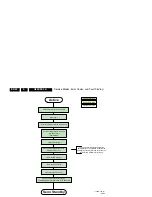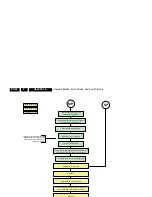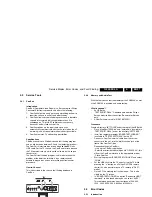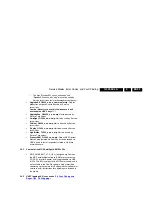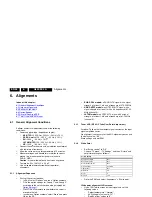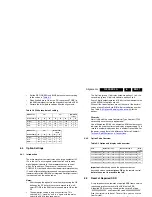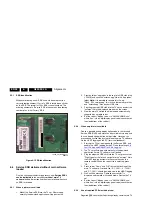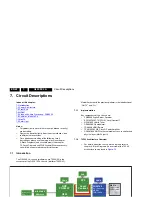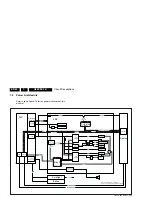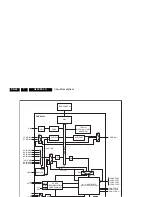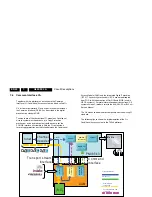
Alignments
EN 36
Q549.2E LA
6.
2009-May-08
6.
Alignments
Index of this chapter:
6.1 General Alignment Conditions
6.2 Hardware Alignments
6.3 Software Alignments
6.4 Option Settings
6.5 Reset of Repaired SSB
6.7 Total Overview SAM modes
6.1
General Alignment Conditions
Perform all electrical adjustments under the following
conditions:
•
Power supply voltage (depends on region):
–
AP-NTSC:
120 VAC or 230 V
AC
/ 50 Hz (
±
10%).
–
AP-PAL-multi:
120 - 230 V
AC
/ 50 Hz (
±
10%).
–
EU:
230 V
AC
/ 50 Hz (
±
10%).
–
LATAM-NTSC:
120 - 230 V
AC
/ 50 Hz (
±
10%).
–
US:
120 V
AC
/ 60 Hz (
±
10%).
•
Connect the set to the mains via an isolation transformer
with low internal resistance.
•
Allow the set to warm up for approximately 15 minutes.
•
Measure voltages and waveforms in relation to correct
ground (e.g. measure audio signals in relation to
AUDIO_GND).
Caution:
It is not allowed to use heat sinks as ground.
•
Test probe: Ri > 10 M
Ω
, Ci < 20 pF.
•
Use an isolated trimmer/screwdriver to perform
alignments.
6.1.1
Alignment Sequence
•
First, set the correct options:
–
In SAM, select “Options”, and then “Option numbers”.
–
Fill in the option settings for “Group 1” and “Group 2”
according to the set sticker (see also paragraph
6.4
Option Settings
).
–
Press OK on the remote control before the cursor is
moved to the left.
–
In submenu “Option numbers” select “Store” and press
OK on the RC.
•
OR:
–
In main menu, select “Store” again and press OK on
the RC.
–
Switch the set to Stand-by.
•
Warming up (>15 minutes).
6.2
Hardware Alignments
Not applicable.
6.3
Software Alignments
Put the set in SAM mode (see Chapter
5. Service Modes, Error
Codes, and Fault Finding
). The SAM menu will now appear on
the screen. Select ALIGNMENTS and go to one of the sub
menus. The alignments are explained below.
The following items can be aligned:
•
Tuner AGC.
•
White point.
To store the data:
•
Press OK on the RC
before the cursor is moved to the
left
.
•
In main menu select “Store” and press OK on the RC.
•
Press MENU on the RC to switch back to the main menu.
•
Switch the set to stand-by mode.
For the next alignments, supply the following test signals via a
video generator to the RF input:
•
EU/AP-PAL models:
a PAL B/G TV-signal with a signal
strength of at least 1 mV and a frequency of 475.25 MHz
•
US/AP-NTSC models:
an NTSC M/N TV-signal with a
signal strength of at least 1 mV and a frequency of 61.25
MHz (channel 3).
•
LATAM models:
an NTSC M TV-signal with a signal
strength of at least 1 mV and a frequency of 61.25 MHz
(channel 3).
6.3.1
Tuner AGC (RF AGC Take Over Point Adjustment)
Purpose: To keep the tuner output signal constant as the input
signal amplitude varies.
No alignment is necessary, for the AGC alignment you can use
the default value : “80”.
Store settings and exit SAM.
6.3.2
White Point
•
Set “Active control” to “Off”.
•
Choose “TV menu”, “TV Settings” and then “Picture” and
set picture settings as follows:
•
Go to the SAM and select “Alignments”-> “White point”.
White point alignment LCD screens:
•
Use a 100% white screen as input signal and set the
following values:
–
“Colour temperature”: “Normal”.
–
All “White point” values to: “127”.
–
“Red BL offset” values to “8”.
–
“Green BL offset” values to “8”.
In case you have a colour analyser:
•
Measure with a calibrated contactless colour analyser in
the centre of the screen. Consequently, the measurement
needs to be done in a dark environment.
•
Adjust the correct x,y coordinates (while holding one of the
White point registers R, G or B on 127) by means of
decreasing the value of one or two other white points to the
correct x,y coordinates (see Table
6-1 White D alignment
values
). Tolerance: dx:
±
0.004, dy:
±
0.004.
•
Repeat this step for the other colour temperatures that
need to be aligned.
•
When finished press OK on the RC and then press STORE
(in the SAM root menu) to store the aligned values to the
NVM.
•
Restore the initial picture settings after the alignments.
Table 6-1 White D alignment values
If you do not have a colour analyser
, you can use the default
values. This is the next best solution. The default values are
average values coming from production.
•
Select a COLOUR TEMPERATURE (e.g. COOL,
NORMAL, or WARM).
Picture Setting
Dynamic backlight
Off
Dynamic Contrast
Off
Colour Enhancement
Off
Picture Format
Unscaled
Light Sensor
Off
Brightness
50
Colour
0
Contrast
100
Value
Cool (11000K )
Normal (9000K)
Warm (6500K)
x
0.270
0.279
0.309
y
0.279
0.287
0.328



